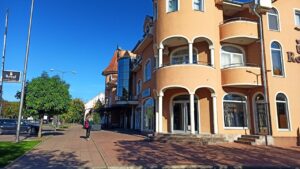Modern construction technologies applied in Subotica.
Subotica, a vibrant city in northern Serbia, is embracing modern construction technologies to enhance its urban development and sustainability. The incorporation of innovative techniques not only improves the efficiency and safety of building processes but also significantly reduces environmental impacts. As the city seeks to enhance its infrastructure and meet the growing needs of its population, various modern technologies are being implemented across different projects. This article explores the cutting-edge technologies being applied in Subotica’s construction sector.
Prefabrication and Modular Construction
One of the most significant advancements in modern construction technologies utilized in Subotica is prefabrication and modular construction. This approach involves constructing building sections off-site in a controlled environment before transporting them to the construction site for assembly. This process accelerates project timelines, reduces waste, and improves overall quality control. By using prefabricated components, Subotica’s builders can ensure consistent standards and minimize the impact of weather delays often associated with traditional construction methods.
In Subotica, several residential and commercial projects have successfully implemented prefabrication techniques. The use of modular construction allows for greater design flexibility, enabling architects to create more innovative structures. Additionally, it lowers labor costs and enhances site safety, as many of the more hazardous tasks are completed in a factory setting. As the demand for quicker and more efficient construction grows, Subotica stands at the forefront of this trend by promoting these advanced building methods.
Furthermore, prefabrication supports sustainability efforts within the city. By reducing material waste and allowing for better energy efficiency in the manufacturing process, this approach aligns with the global push towards greener construction practices. Subotica’s commitment to sustainable urban development is exemplified by these innovative building methods, positioning the city as a leader in modern construction.
3D Printing Technologies
Another exciting modern construction technology making waves in Subotica is 3D printing. This revolutionary method allows for the rapid production of complex structural components, reducing both time and labor costs involved in construction. 3D printing enables builders to create intricate designs that would be difficult or impossible to achieve using conventional construction tools. In Subotica, architects are beginning to explore how 3D printing can enhance both aesthetic appeal and functional efficiency in new buildings.
Additionally, 3D printing offers significant benefits in terms of material efficiency. By using only the necessary materials for construction, this technology reduces waste and lowers costs. Local construction companies in Subotica are partnering with developers to experiment with 3D-printed elements in both residential and commercial projects. The administration has also expressed interest in using 3D printing to create more affordable housing options, exemplifying the technology’s potential to address pressing urban challenges.
Moreover, the implementation of 3D printing aligns with Subotica’s broader goals of technological innovation and urban renewal. As the city seeks to improve its infrastructure while remaining environmentally conscious, 3D printing provides a forward-thinking solution. This technology not only enhances speed and cost-effectiveness in construction but also contributes to the creation of unique and sustainable designs, paving the way for a modern urban landscape.
Smart Building Technologies
In an era increasingly driven by technology, smart building technologies are finding a foothold in Subotica’s construction landscape. By incorporating advanced automation, building management systems, and energy-efficient technologies, intelligent buildings enhance the functionality and sustainability of urban spaces. In Subotica, developers are incorporating smart technologies into both new constructions and renovations, which aim to improve energy management and occupant comfort.
Smart building frameworks utilize various technologies, including Internet of Things (IoT) sensors and advanced energy management systems, to monitor and automate building operations. These systems allow for real-time data collection on energy usage, lighting, heating, and ventilation, enabling building managers to adjust operations for optimal efficiency. Subotica is witnessing a shift towards buildings that actively contribute to energy savings, which is vital in the context of rising energy costs and the green energy movement.
Furthermore, smart technologies in construction promote greater connectivity among residents and facilities. For instance, systems for remote monitoring and control can enhance security and streamline maintenance processes. As Subotica continues to evolve as a modern urban center, the integration of smart building technologies ensures that it not only meets current demands but also anticipates future needs, leading to a more sustainable and efficient city infrastructure.
In conclusion, Subotica is making significant strides in modern construction technologies that enhance its urban landscape. Through the adoption of prefabrication and modular construction, 3D printing, and smart building technologies, the city is not only improving efficiency but also embracing sustainability in its development projects. These advancements position Subotica as a forward-thinking city committed to innovation in construction practices. As these technologies continue to evolve, they will play a crucial role in shaping the city’s future, ensuring that Subotica remains a competitive and dynamic urban hub.


